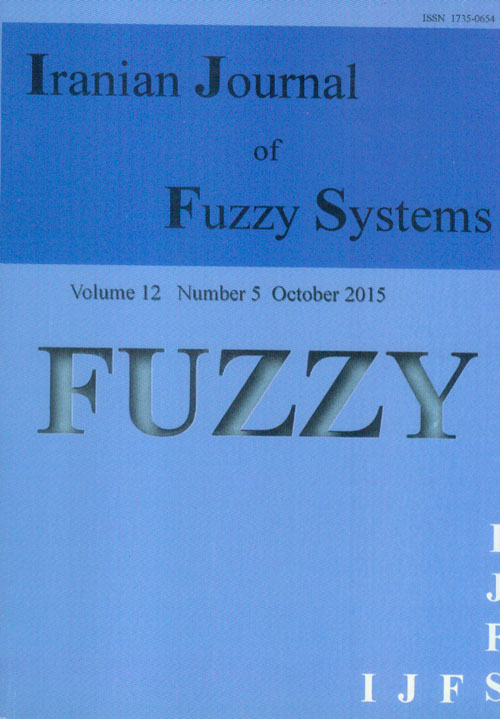فهرست مطالب

Iranian journal of fuzzy systems
Volume:12 Issue: 5, Oct 2015
- 170 صفحه،
- تاریخ انتشار: 1394/08/20
- تعداد عناوین: 7
-
-
Page 1Following the categorical approach to universal algebra through algebraic theories, proposed by F.~W.~Lawvere in his PhD thesis, this paper aims at introducing a similar setting for general topology. The cornerstone of the new framework is the notion of emph{categorically-algebraic} (emph{catalg}) emph{topological theory}, whose models induce a category of topological structures. We introduce the quasicategory of catalg topological theories and consider its functorial relationships with the quasicategory of the categories of models, in order to provide convenient means for studying topological structures via the properties of their corresponding theories.Keywords: Algebra, Algebraic theory, Comma category, Categorically, algebraic topology, Poslat topology, Powerset theory, Topological system, Topological theory, Variety
-
Page 45Based on credibilistic value-at-risk (CVaR) of regular fuzzy variable, we introduce a new CVaR reduction method for type-2 fuzzy variables. The reduced fuzzy variables arecharacterized by parametric possibility distributions. We establish some useful analytical expressions for mean values and second order moments of common reduced fuzzy variables. The convex properties of second order moments with respect to parameters are also discussed. Finally, we take second order moment as a new risk measure, and develop a mean-moment model to optimize fuzzy portfolio selection problems. According to the analytical formulas of second order moments, the mean-moment optimization model is equivalent to parametric quadratic convex programming problems, which can be solved by general-purpose optimization software. The solution results reported in the numerical experiments demonstrate the credibility of the proposed optimization method.Keywords: Credibilistic value, at, risk, Reduced fuzzy variable, Parametric possibility distribution, Second order moment
-
Page 77In this paper, linear matrix inequality (LMI) approach for synchronization of chaotic fuzzy cellular neural networks (FCNNs) with discrete and unbounded distributed delays based on sampled-data control is investigated. Lyapunov-Krasovskii functional combining with the input delay approach as well as the free-weighting matrix approach are employed to derive several sufficient criteria in terms of LMIs ensuring the delayed FCNNs to be asymptotically synchronous. The restriction such as the time-varying delay required to be differentiable or even its time-derivative assumed to be smaller than one, are removed. Instead, the time-varying delay is only assumed to be bounded. Finally, numerical examples and its simulations are provided to demonstrate the effectiveness of the derived results.Keywords: Chaos, Fuzzy cellular neural networks, Linear matrix inequality, Sampled, data control, Synchronization
-
Page 99This article introduces the notions of functional space and concept as a way of knowledge representation and abstraction for Reinforcement Learning agents. These definitions are used as a tool of knowledge transfer among agents. The agents are assumed to be heterogeneous; they have different state spaces but share a same dynamic, reward and action space. In other words, the agents are assumed to have different representations of an environment while having similar actions. The learning framework is $Q$-learning. Each dimension of the functional space is the normalized expected value of an action. An unsupervised clustering approach is used to form the functional concepts as some fuzzy areas in the functional space. The functional concepts are abstracted further in a hierarchy using the clustering approach. The hierarchical concepts are employed for knowledge transfer among agents. Properties of the proposed approach are tested in a set of case studies. The results show that the approach is very effective in transfer learning among heterogeneous agents especially in the beginning episodes of the learning.Keywords: Reinforcement Learning, Transfer Learning, Heterogeneous Agents, Hierarchical Concepts
-
Page 117Although there are many excellent ways presenting the principle of the classical calculus, the novel presentations probably leads most naturally to the development of the non-Newtonian calculus. The important point to note is that the non-Newtonian calculus is a self-contained system independent of any other system of calculus. Since this self-contained work is intended for a wide audience, including engineers, scientists and mathematicians. The main purpose of the present paper is to construct of fuzzy numbers with respect to the non-Newtonian calculus and is to give the necessary and sufficient conditions according to the generalization of the notion of fuzzy numbers by using the generating functions. Also we introduce the concept of non-Newtonian fuzzy distance and give some properties regarding convergence of sequences and series of fuzzy numbers with some illustrative examples.Keywords: Non, Newtonian calculus, Fuzzy level sets, Trapezoidal fuzzy numbers, Convergence of fuzzy sequences, series
-
Page 139In this paper, we introduce a function in order to measure the distance between two order intervals of fuzzy numbers, and show that this function is a metric. We investigate some properties of this metric, and finally present an application. We think that this study could provide a more general framework for researchers studying on interval analysis, fuzzy analysis and fuzzy decision making.Keywords: Fuzzy number, Order interval of fuzzy numbers, Decision making
-
Page 149This paper demonstrates the redundancies concerning the increasing popular soft set" approaches to general topologies. It is shown that there is a complement preserving isomorphism (preserving arbitrary $widetilde{bigcup}$ and arbitrary $widetilde{bigcap}$) between the lattice ($mathcal{ST}_E(X,E),widetilde{subset}$) of all soft sets on $X$ with the whole parameter set $E$ as domains and the powerset lattice ($mathcal{P}(Xtimes E),subseteq$) of all subsets of $Xtimes E$. It therefore follows that soft topologies are redundant and unnecessarily complicated in theoretical sense.Keywords: Soft set, Soft topology

